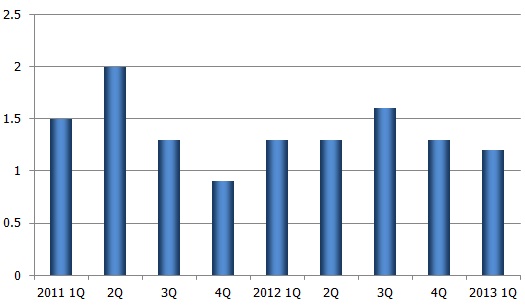Problems in industry do not affect GDP growth in the first quarter of 2013
According to the CSB flash estimate, in the first quarter of 2013, GDP growth was 1.2% (quarter-on-quarter, seasonally adjusted). The annual rate of growth moderated to 3.1%. Over the last two years, the average quarterly growth of GDP was 1.4%; thus it can be concluded that, despite unfavourable developments both in the external and domestic environment, the economic growth has only slightly moderated in the first quarter this year.
The previously available preliminary data suggested, however, that GDP growth in the first quarter might have fallen more rapidly. The following factors pointed to that:
- Output volume data in manufacturing, showing a 3.6% quarter-on-quarter decline in the first quarter of 2013. Moreover, the above data do not comprise the major drop in production at the JSC Liepājas metalurgs where the production capacity utilisation contracted considerably starting with April.
- A gradual change in the situation was also suggested by the confidence indicators, released by the European Commission, that have climbed down from the highs seen at the turn of the year.
- The transport sector preliminary indicators on the rail freight turnover and freight turnover at Latvian ports also suggested a further decline in the demand for transportation services.
At the same time, retail trade turnover points to the persistence of the domestic activity. In the construction sector activity is also on the rise.
The fact that GDP growth rates have remained relatively high is actually a surprise. Obviously, other sectors, where accurate data are not available yet, have had a rapid increase in value added. The real estate sector is the main candidate for accelerated growth: over the last quarters it has reported admirable increases in value added, making even sector experts really surprised. Higher-than-forecast growth could also be seen in the transport sector, but then mostly on account of freight transportation by road as data on freight turnover by rail and at ports do not suggest a breakthrough.
However, despite the data released today, GDP growth in 2013 is not likely to reach the levels observed in 2012 and 2011. Several factors testify to that:
- The problems faced by the JSC Liepājas metalurgs will mostly be reflected in the manufacturing data for the second quarter of 2013, suggesting that the GDP growth for the second quarter will also be slower than we have been accustomed to see of late.
- The global economic conditions still show no explicit signals pointing to a considerable improvement of the situation and an increase in the demand for Latvian exports. Although we have emphasized in our previous publications time and again that Latvian exporters have, at least partly, been able to re-direct their sales towards other markets, still we are not fully protected against weak aggregate external demand.
- Manufacturers of wood also admit that in 2013 growth potential is limited: on the one hand, it is the lack of an increase in demand; on the other hand, lack of local resources (sawn wood) and, in some cases, also lack of production capacities.
- Also for agriculture this year might not turn out to be as successful as the previous one with its record high harvests. In the second half of the year it could have a negative effect on exports of goods.
The recent accelerated growth in retail trade, the robust increase in construction, industrial output sales data (in recent months a higher rise in the manufacturing sales was posted in the domestic market) make one consider the fact that in a situation where the external economic environment no longer stimulates a rapid surge in exports, it is the domestic demand – private consumption and investments – that will play an increasingly important role in the economic growth in the near future. Nevertheless, as we have already pointed out before, the domestic demand in Latvia will not be able to sustain the economic growth in the longer term, unless the external demand recovers in the future.
Chart. GDP growth (quarter-on-quarter, at constant prices, seasonally adjusted data)

Source: CSB.
* CSB flash estimate
Textual error
«… …»






